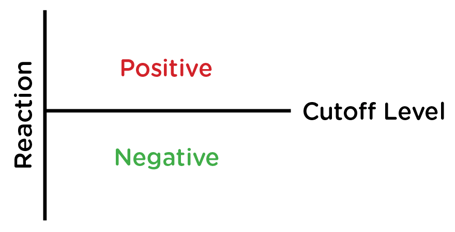Richmond, Va. – With very few exceptions, drug test levels should only be compared to a cutoff to determine whether a sample (e.g., urine, oral fluid, or hair) is positive or negative. A sample that produces a drug test level below the cutoff is deemed negative, while a sample that produces a drug test level at or above the cutoff is deemed positive. Drug test levels in urine and hair are nonlinear with respect to concentration (i.e., not a straight line), meaning that the amount of the drug ingested cannot be determined by the concentration in the urine or hair sample. This also means that interpretations of drug test levels should only be done by toxicologists with the appropriate credentials. Moreover, due to differences in how individuals metabolize substances, these levels are often only useful to determine whether a test is positive or negative.
Qualitative or Quantitative Testing
The two test methods used to determine drug test levels are qualitative (screening) and definitive (confirmation).

A qualitative test, also known as a screen, compares a reference sample to an unknown sample. A screen identifies classes of drugs (such as opiates) without identifying a specific drug. Thus, the level reported represents all the compounds in that class detected by the test. The screen result should therefore only be considered positive or negative.
A quantitative test, also known as a confirmation, compares an unknown sample against a defined numerical range. The defined range is based on a calibration curve with five to seven data points. The calibration curve can give a definitive amount of a drug that is present in the sample. The interpretation of the result is not just positive or negative, but also “how much”. Interpretation of drug levels is not straightforward however, and should still only be completed by a qualified toxicology staff.

Determining Cutoff Levels
Cutoff levels are determined by (i) use case; (ii) scientific validity; (iii) forensic defensibility; and (iv) sample type.
Use Case: Substance Use Monitoring or Workplace
- Substance Use Monitoring: probation, treatment courts, child protective services, pretrial, and other criminal justice tracks
- Workplace: pre-employment, reasonable suspicion, accidents, and random
- Scientific Validity: method-specific and based on validation studies conducted in accordance with scientific standards
- Forensic Defensibility: accuracy, predictive value, and known rate of error
- Sample Type: urine, oral fluid, hair, blood, and breath – substances are detectable in various sample types at different times and in different concentration levels (do not compare the result of a urine sample to an oral fluid sample)
For both screening and confirmation testing, there is an upper limit to the calibration range, above which drug levels cannot be determined with any accuracy. Levels above this are usually just considered “above the upper limit of linearity” – which means highly positive.
Exceptions
1. When monitoring marijuana use, urine drug test levels, adjusted for creatinine over a thirty-day period, are useful for distinguishing new use from residual use
2. Breath alcohol tests are useful for determining if a person is currently intoxicated
3. Blood tests are useful for postmortem purposes
In conclusion, screening drug test levels for substance use monitoring, particularly in the criminal justice system, are qualitative in nature and should not be used for anything other than determining if a sample is positive or negative.
